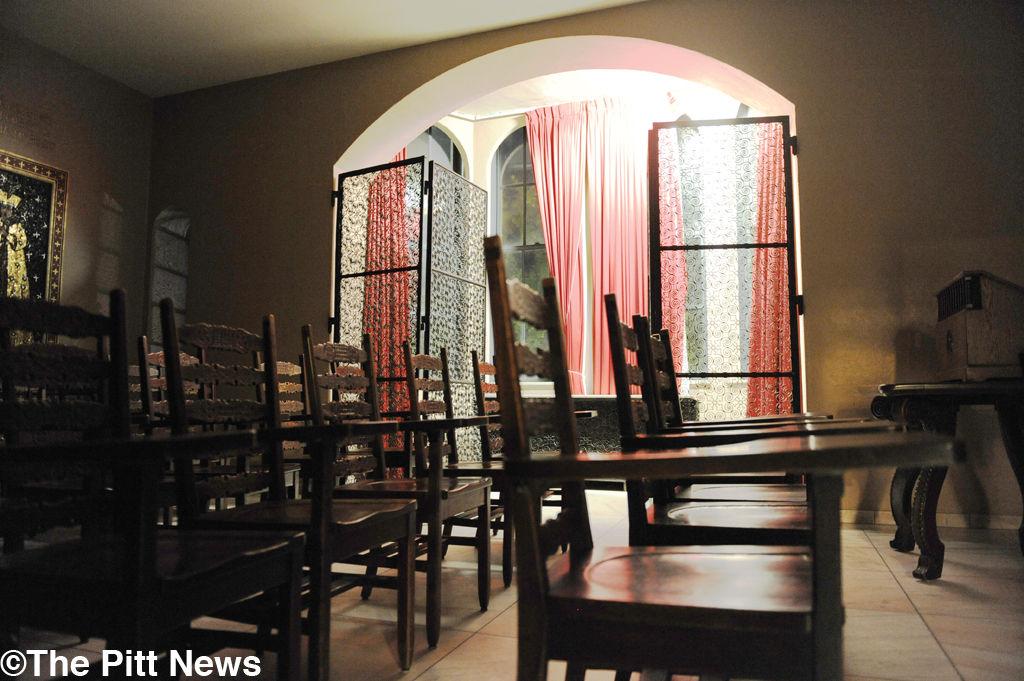Nationality Rooms: What does politics have to do with culture?


Several weeks ago, Oakland celebrated its 175th Anniversary with a free community event called “Oakland Forever.” The schedule, meant to highlight Oakland’s vibrant legacy, included tours of the Cathedral and its Nationality Rooms.
It was during one of these tours that a woman approached me — where I sat huddled over a book on the first floor of the Cathedral — and asked me a simple question: “Do they actually use these rooms?”
In the moment, I had simply smiled and nodded. After all, I’d had several classes in the Nationality Rooms myself. Yet her question lingered in my mind.
What purpose were these rooms actually serving?
It’s an essential question to ask, especially during Homecoming — when students and alumni look back and celebrate the traditions that make their school unique. However, as Nationality Rooms are traditionally thought to reflect the cultures of the people which they are supposed to represent, many flaws with the intended portrayal remain.
Originally, the University established the Nationality Rooms to represent the ethnicities that reflected Pittsburgh’s diverse heritage, according to their website. Their construction was meant to incorporate the community within the Cathedral’s design — the University invited community members to provide a room representing their heritage with the requirement of forming a Room Committee to oversee the construction of the room and, later, its functions altogether.
Over the years, the Nationality Rooms have become symbols of cultural awareness. Devoted to the ideal of educating through cultural integration, the Nationality Rooms Committee sponsors scholarship and grant programs that have afforded students the opportunity to study abroad since 1926.
Additionally, the rooms and the cultures they represent serve as platforms for hosting various lectures, seminars, concerts and other social events that can build onto their foundation of cultural education.
Yet the cultural education that the Nationality Rooms attempt to represent is severely limited in a key regard.
Prior to creation, each Nationality Room was subject to several principles meant to maintain a “commonality of purpose, authenticity and non-political cultural emphasis.” They include requirements such as illustrating architectural design traditions as recognized by the United States’ Department of State, a non-political design depicting a period prior to 1787, lack of political symbols or depictions of any living person and lack of donor recognition.
Pitt should aim to use the Nationality Rooms to educate students, not only in terms of “the good things immigrants brought to America,” but also in terms of their journey, however filled with political turmoil it may have been.
Of course, there’s no harm in celebrating a nation’s architectural designs, unless you should happen to be the eyes of a modernist architect. Yet, an issue presents itself when that same architectural glorification becomes rooted in “cultural education” endeavors — which has come to be the case with Pitt’s Nationality Rooms.
Clearly, Pitt has long held a tradition of remaining distant from matters of politics when it came to the use of the Nationality Rooms — aiming to focus, instead, on the purely cultural merits of the nations represented.
But how do you examine a nation’s culture without addressing political influences?
For example, how can we celebrate early Americanism without acknowledging the very political conflicts that founded our nation? Or explore African heritage without recognizing the cultural significance of influences like imperialism or apartheid?
Additionally, to claim to maintain an ongoing sense of cultural education without addressing current political conflicts is an ironic feat. After all, much of today’s cultures are rife with political conflicts. There’s Russia under Putin and its conflict with Ukraine, communism in China, Scotland and its recent endeavors for independence — political phenomena are constantly shaping and forming the cultures of these nations. After all, the Ukranian culture might look very different today if it was still a part of Russia.
Simply put, a nation’s culture is a product of its history and its politics.
Today, the Nationality Rooms stand as testaments to several profound ideals: community integration, cultural awareness and ethnic identity. What’s more, they’ve managed to do so by completely ignoring the very factors that go into a nation’s culture.
To represent a culture is to pay homage to the full extent of its history, of which politics is certain to have played a key role. A focus on current cultural elements develops a student’s awareness and maintains a sense of community integration.
To continue our tradition of distance from political elements when it comes to our Nationality Rooms conflicts with what we have traditionally strived to achieve in terms of cultural education.
So, let’s make this Homecoming a celebration of Pitt’s more culturally integrated future by separating from our politically distant past. Let’s emphasize the importance that political turmoil and strife had in molding the various ethnicities of our forefathers by including these elements into the nationality rooms.
After all, any school can have pretty rooms, but only Pitt has Nationality Rooms.
Write to Bethel at beh56@pitt.edu
Recent Posts
First Place | The summer apartment
See two girls: one 19, the other 20. They’re both engineering students far from home,…
Second Place | Moist and buttery gluten-free coffee cake
This gluten-free coffee cake is so indulgent you would never even know it was free…
Third Place | Dinner rush
Runner, please. Hands. Behind. 86 zucchini. Heard. There’s a slight ringing in my ears, and…
Runner-Up | Let me tell you about hobbies and death
Well, everyone has to have a hobby. Mom says you gotta love something or else…
Runner-Up | Artemis
In her dream, the moon exploded. Something hit it from behind — some dark shadow,…
Runner-Up | Setting the scene
My father and I are running through the forest. Our footsteps pound with silent desperation…


